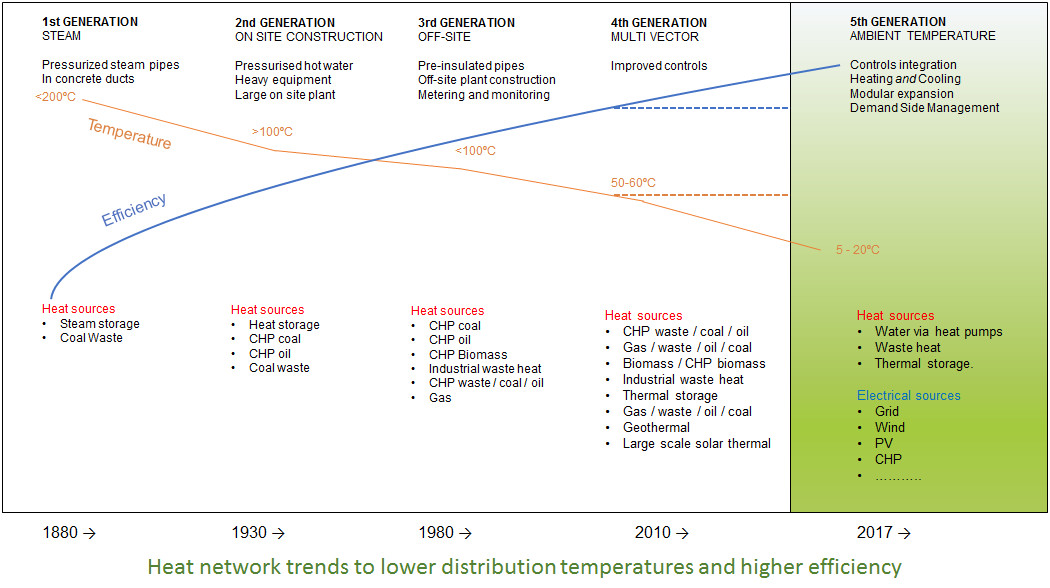District Heating – Community Heating – Heat Sharing Networks™
Traditional District heating is a system for generating heat at a central location and distributing heat at high temperatures for space heating and hot water to residential and commercial properties using heat networks. District heating plants can provide higher efficiencies and lower carbon emissions than local boilers. Some District networks also provide a cold distribution circuit to facilitate cooling.
Heat Sharing – Community Heating – Heat Networks – Decarbonising Heat

There is an alternative means of sharing heat using a lower temperature distribution circuit. This communal circuit, which is linked to a communal ThermalBank, can be accessed by each member of the group which uses its own heat pump to raise the temperature to the temperature it requires for its own heating and hot water requirements. Heat Sharing Networks™ are also termed "Cold Water Heat Networks", "Low Temperature Heat Networks", "Ambient Ground Loops", or "Fifth Generation Heat Networks".
A heat sharing circuit is cheaper to install than a high temperature circuit because it does not require the same degree of insulation to prevent heat losses to the ground. In fact, heat exchange with the ground that the pipes pass through can be beneficial: the ground adjacent to the pipes extends the contact with the ground and the pipes can draw heat from the ground.
Those buildings with excess heat can exchange heat with the Heat Sharing Network. This is more efficient for them than heat exchanging with hot external air. It also raises the temperature of the Heat Sharing Network for the benefit of those whose heat pumps need to extract heat.
Interseasonal Heat Transfer™ has many advantages for district heating. IHT can ensure that building groups have a reliable, independent and sustainable source of Renewable Heating and Renewable Cooling.
Interseasonal Heat Transfer™ can also bring On-site Renewable Energy to district heating, instead of relying on external fossil fuel supplies commonly used in Combined Heat and Power (CHP) systems.
Heat Sharing based on Interseasonal Heat Transfer can ...
- provide a reliable and low-cost green energy source for space heating and cooling
- save over 70% on carbon emissions on heating compared to emissions from gas boilers
- save over 80% on carbon emissions on cooling buildings compared to emissions (from the power stations) that power electric air conditioning and electric chillers
- provide a low-cost heat energy (or cooling) source for industrial processes
- provide opportunities for reducing carbon emissions by re-cycling solar energy instead of burning fossil fuels
- provide the opportunity to recover heat from buildings with high occupancy and high passive heat gains and transfer it to buildings needing heat
- attract Renewable Heat Incentive cashback for use of ground source heat pumps
- attract Renewable Heat Incentive cashback for use of solar thermal collectors
- improve urban air quality by avoiding combustion of fossil fuels or biomass in densely populated areas

Groups of Buildings
IHT is very well suited to providing Heat Sharing to groups of houses. The cost of providing an efficient installation can be shared across a number of houses, and the benefits increase if the district heating system includes other buildings such as schools or offices whose heating and cooling requirements may follow a different daily pattern (and different weekly pattern) from the heating demand for houses. Where the district covers offices, or data centres, the heat recovered from cooling these buildings can be transferred to homes requiring heating (or other buildings with a heating need such as a community swimming pool).
Where the cooling demand is separated in time from the heating demand, surplus heat can be stored in ThermalBanks from the time it is available to the time it is needed. This efficient use of heat is at the heart of Interseasonal Heat Transfer and enables ICAX to provide cheaper heating and cheaper cooling than conventional methods, as well as proving heating and cooling with a very low carbon footprint.
Sharing heat between buildings
Many commercial buildings have an overall cooling load over the year: they have a requirement to disperse heat. This often applies to modern office buildings in south east England with extensive glazing and high solar gains. These buildings may be adjacent to older buildings with an overall annual heating load. ICAX has developed systems to allow for the transfer of heat between buildings: this form of heat transfer can save fuel and carbon emissions for both buildings.
Both buildings can benefit from a "heat sharing dividend" when they enjoy "joined up heating".
Other buildings with a need to loose excess heat include underground train tunnels, data centres and supermarkets.
A comparison of the advantages of Heat Sharing Networks over traditional gas powered District Heating is shown in the Heat Sharing Table.
District Energy Management System
ICAX has developed a District Energy Management System ("EMS") to control the transfer of thermal energy from the times and places it is most cheaply available to the times and places where it is most needed. This involves control of Thermal Energy Storage to maximise the benefits, minimise costs and minimise carbon emissions.
Even in a group of similar houses there will be variations in the heating requirements between houses: some houses will be unoccupied during the working day, others with small children, or pensioners, may have higher heating loads during the day. IHT can meet these variations in demand successfully – and meter the use of heating in different buildings.
The combined benefits make Interseasonal Heat Transfer an attractive option for offices, schools and universities, hospitals, community centres, urban and suburban housing developments, industrial developments and private houses aiming for low energy use based on solar power.
Energy Hub – sharing warmth feels good
District Heating using Interseasonal Heat Transfer combines the benefits of on-site renewable energy with sharing heating loads between neighbours.
See Energy Hub European District Heating Project.
The Intranet of Heat
This new heat sharing infrastructure is the birth of an "Intranet of Heat". The Intranet of Heat enables the exchange of information about sources and needs of heat – and cooling – and then allows heat exchange from those buildings with surplus heat to those in need of heat.
See Ground Source Heating See Ground Source Cooling See Ground Source Energy
See also Heat Networks Investment Project



